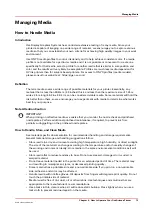
NOTE
Dirty media can affect image quality and reliability of printer output. If you wipe the media with a
tack cloth before printing, it will reduce dust and debris buildup on the carriage underside. The
tack cloth removes static and also removes dust and debris that tend to attract stray ink drops.
Tack cloths are used by auto-body shops to clean cars before painting. Océ does not provide
additional tack cloths beyond what is in the Accessory kit. If you did not receive a cloth or if you
wish to purchase additional tack cloths, they are available at local hardware or auto supply
stores.
Carriage Collision Recovery
If something on the table is higher than the media (or if the media is thicker than what is actually
set in the print job settings), a carriage collision may occur. If a collision occurs, the carriage will
stop and display a message on the User Interface panel. After the operator clears the offending
media from the table and before the next print is started, printhead maintenance must be
performed (See Printer Maintenance section).
How to Handle Media with Uncured Ink
If the UV ink is not properly cured, wear nitrile gloves when you handle prints. This will minimize
the risk of skin irritation and sensitization from possible exposure to uncured ink.
Media Adhesion
Some media have better adhesion quality than others. Factors such as the amount of ink used
and the amount of curing energy from the UV lamps can affect adhesion.
For more information on media adhesion, see Application Bulletin 6 on the customer support
web site.
Media-Related Application Bulletins
For additional information on various aspects of handling and managing media refer to the
Customer Support web site. See Appendix A of this document for a list of available bulletins or
visit the web site to download bulletins:
https://dgs.oce.com/
Thermal Expansion of Media
When imaging on media that will expand when subjected to heat (e.g., styrene or Plexiglas, etc),
don’t wedge the media by butting other material against it as this may cause the media to buckle.
Also if multiple pieces of the media are used, allow enough space between the pieces to allow for
thermal expansion. If you overprint on media that expands when heat is applied, we recommend
that you group the desired image with the preceding image so the media stays at a consistent
temperature.
Thermal Deformation of Media
Some heat-sensitive media may deform when subjected to high heat. If this occurs you can
reduce the lamp power from the default setting of 7. You can also try to print uni-directional
using only the trailing lamp (to do this set the power of the leading lamp to 0).
How to Handle Media
74
Chapter 5 - How to Operate Your Océ Arizona Printer
Océ Arizona 1200 Series
Содержание arizona 1240 GT
Страница 1: ...User guide Oc Arizona 1200 Series Revision 3010121377...
Страница 6: ...Contents 6 Oc Arizona 1200 Series...
Страница 7: ...Chapter 1 Introduction...
Страница 11: ...Chapter 2 Product Compliance...
Страница 15: ...Chapter 3 Safety Information...
Страница 34: ...Roll Media Safety Awareness 34 Chapter 3 Safety Information Oc Arizona 1200 Series...
Страница 35: ...Chapter 4 How to Navigate the User Interface...
Страница 56: ...Software Update Module 56 Chapter 4 How to Navigate the User Interface Oc Arizona 1200 Series...
Страница 57: ...Chapter 5 How to Operate Your Oc Arizona Printer...
Страница 78: ...Media Registration 78 Chapter 5 How to Operate Your Oc Arizona Printer Oc Arizona 1200 Series...
Страница 79: ...Chapter 6 Operating the Oc Arizona 1200 XT...
Страница 85: ...Chapter 7 Roll Media Option...
Страница 109: ...Chapter 8 Static Suppression Option...
Страница 113: ...Chapter 9 How to Manage a White Ink Workflow...
Страница 157: ...Chapter 10 Ink System Management...
Страница 161: ...Chapter 11 Troubleshooting...
Страница 163: ...Chapter 12 Printer Maintenance...
Страница 206: ...How to Remove Uncured Ink on the Capstan 206 Chapter 12 Printer Maintenance Oc Arizona 1200 Series...
Страница 207: ...Appendix A Application Information...
















































